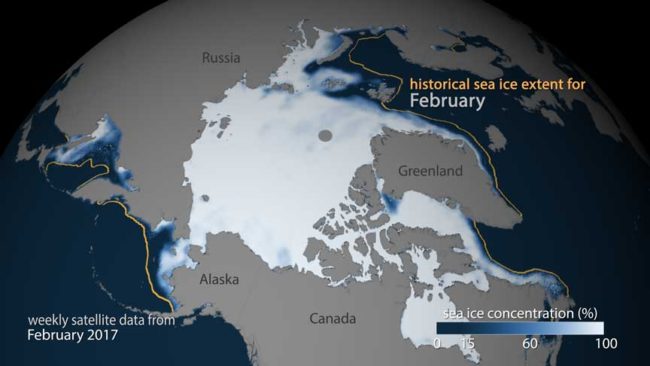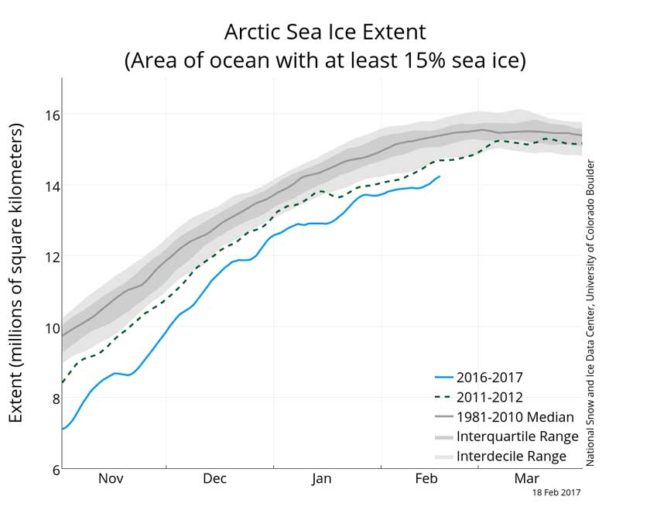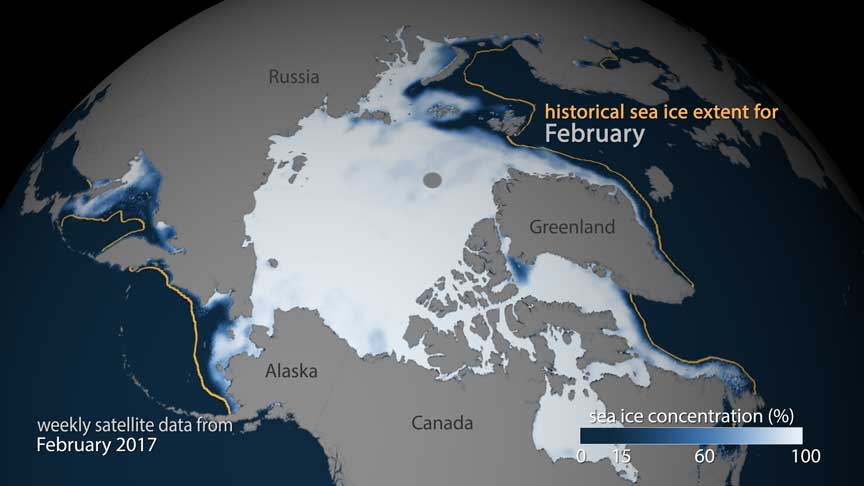
Bryan Thomas, who works as station chief at NOAA’s Point Barrow, Alaska, observatory is deeply troubled. As he sits within his office there in Alaska, he can look North out over the Arctic ocean in the middle of February. It should all be sea ice, but it is not …
“I could see what’s known as water-skyoffsite link — the reflection of dark water on clouds on the horizon,” Thomas said. “From land, you can maybe see 10 miles, and the clouds were telling us that somewhere in that distance there was open water.”
“Here we are in February, when we expect maximum sea ice extentoffsite link,” Thomas added. “This might be all we’re going to get.”
This is not Normal
What is being observed and measured are record temperatures and extraordinary sea-ice conditions …
-
Sea ice observed in January in the Arctic was the lowest in the 38 years of satellite recordoffsite links and 100,000 square miles less than 2016. That’s equivalent to the size of Colorado.
-
The average temperature of 4.4 degrees F in Barrow, Alaska, from November 2016 through January 2017 shattered the old record of 0 degrees set between 1929 and 1930. From 1921 to 2015, the average November-to-January temperature in Barrow was -7.9 degrees F.
-
Temperatures in the Arctic for the calendar year 2016 were by far the highest since 1900. Each of the past four years was among the top 10 warmest on record.
The Arctic Data is now at record breaking lows
“The late and faltering formation of sea ice this winter is one of many signs of extraordinary change in the Arctic“
– Mark Serreze, director of the National Snow and Ice Data Center
Let’s take a quick look at where things now stand with the daily NSIDC data…

The repeated surges of warm air moving into the Arctic over the past few months is quite frankly astonishing, this has been slowing down the normal winter sea ice growth.
The 2017 Melt Season will soon commence
Will 2017 set a record for the least amount of sea ice ever recorded at winter’s end?
We are not there yet, but given the observations made so far, that is clearly how things will pan out.
“We’re starting melt season on very, very bad footing.offsite link” – Mark Serreze, director of the National Snow and Ice Data Center
It is not just the Arctic
What’s happening in the Arctic isn’t staying in the Arctic. Profound changes are coming to the state’s interior as well.
This winter was cold by today’s climate standards, By historic standards, it was completely uninteresting. I’m ready to say beyond any doubt that interior Alaska simply does not experience the temperatures it did in the past.
– Richard Thoman, a meteorologist for NOAA’s National Weather Service Alaska Region.
It is all happening really fast …
“We knew the Arctic would be the place we’d see the effects of climate change first, but what’s happened over the last couple of years has rattled the science community to its core, Things are happening so fast, we’re having trouble keeping up with it. We’ve never seen anything like this before.”
– Mark Serreze, director of the National Snow and Ice Data Center
Source: NOAA Press Release 17th Feb.
Related
See how decreasing Arctic sea ice is affecting animal life:
Watch “Animals of the Ice” from NOAA Ocean Today. Below is one of the many clips you will find at that link …
